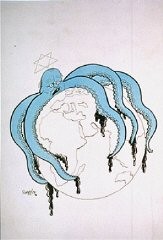<< Previous | Displaying results 6401-6425 of 6707 for "" | Next >>
-
Flag graphic for US 4th Infantry Division
PhotoA digital representation of the United States 4th Infantry Division's flag. The US 4th Infantry Division (the "Ivy" division) was established in 1917 and fought in World War I. During World War II, they were involved in D-Day, the liberation of Paris, and the Battle of the Bulge. The division also captured the city of Nuremberg and discovered a Dachau subcamp near Haunstetten. The 4th Infantry Division was recognized as a liberating unit in 1992 by the United States Army Center of Military History and…

-
Flag graphic for US 63rd Infantry Division
PhotoA digital representation of the United States 63rd Infantry Division's flag. The US 63rd Infantry Division (the "Blood and Fire" division) was established in 1943. During World War II, they took the town of Heidelberg and liberated several Kaufering subcamps. The 63rd Infantry Division was recognized as a liberating unit in 2000 by the United States Army Center of Military History and the United States Holocaust Memorial Museum (USHMM).
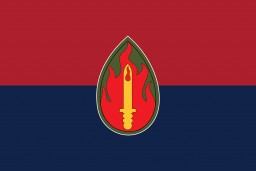
-
Flag graphic for US 65th Infantry Division
PhotoA digital representation of the United States 65th Infantry Division's flag. The US 65th Infantry Division (the "Battle Axe" division) was established in 1943. During World War II, they took the cities of Regensburg, Passau, and Linz. The division also overran a subcamp of the Flossenbürg concentration camp. The 65th Infantry Division was recognized as a liberating unit in 1994 by the United States Army Center of Military History and the United States Holocaust Memorial Museum (USHMM).
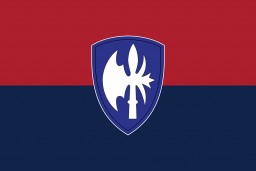
-
Flag graphic for US 69th Infantry Division
PhotoA digital representation of the United States 69th Infantry Division's flag. The US 69th Infantry Division ("Fighting 69th") was established in 1943. During World War II, they captured the city of Leipzig and uncovered Leipzig-Thekla, a subcamp of Buchenwald. The 69th Infantry Division was recognized as a liberating unit in 1993 by the United States Army Center of Military History and the United States Holocaust Memorial Museum (USHMM).
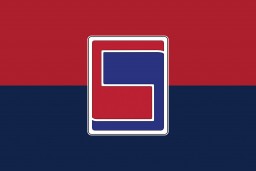
-
Flag graphic for US 6th Armored Division
PhotoA digital representation of the United States 6th Armored Division's flag. The US 6th Armored Division is also known as the "Super Sixth." During World War II, they were involved in the Battle of the Bulge and overran the Buchenwald concentration camp. The 6th Armored Division was recognized as a liberating unit in 1985 by the United States Army Center of Military History and the United States Holocaust Memorial Museum (USHMM).

-
Flag graphic for US 71st Infantry Division
PhotoA digital representation of the United States 71st Infantry Division's flag. The US 71st Infantry Division (the "Red Circle" division) was established in 1943. During World War II, they were involved in taking the cities of Coburg, Bayreuth, and Regensburg. The division also liberated Gunskirchen, a subcamp of Mauthausen. The 71st Infantry Division was recognized as a liberating unit in 1988 by the United States Army Center of Military History and the United States Holocaust Memorial Museum (USHMM).

-
Flag graphic for US 80th Infantry Division
PhotoA digital representation of the United States 80th Infantry Division's flag. The US 80th Infantry Division (the "Blue Ridge" division) was established in 1917 and fought in World War I. During World War II, they were involved in the Battle of the Bulge. The division entered Buchenwald concentration camp and liberated Ebensee, a subcamp of Mauthausen. The 80th Infantry Division was recognized as a liberating unit in 1985 by the United States Army Center of Military History and the United States Holocaust…
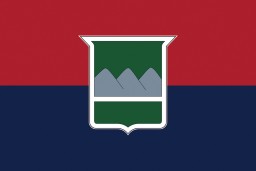
-
Flag graphic for US 82nd Airborne Division
PhotoA digital representation of the United States 82nd Airborne Division's flag. The US 82nd Airborne Division (the "All American" division) was established in 1918 and fought in World War I. During World War II, they were involved in D-Day and Battle of the Bulge. The division also overran Wöbbelin, a subcamp of Neuengamme. The 82nd Airborne Division was recognized as a liberating unit in 1991 by the United States Army Center of Military History and the United States Holocaust Memorial Museum (USHMM).
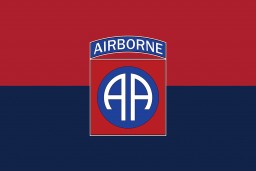
-
Flag graphic for US 83rd Infantry Division
PhotoA digital representation of the United States 83rd Infantry Division's flag. The US 83rd Infantry Division (the "Thunderbolt" division) was established in 1917 and fought in World War I. During World War II, they were involved in the Battle of the Bulge and captured the city of Halle. The division also encountered Langenstein, a subcamp of Buchenwald. The 83rd Infantry Division was recognized as a liberating unit in 1993 by the United States Army Center of Military History and the United States…
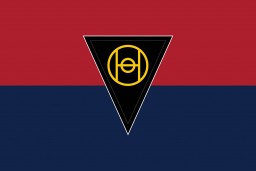
-
Flag graphic for US 84th Infantry Division
PhotoA digital representation of the United States 84th Infantry Division's flag. The US 84th Infantry Division (the "Railsplitter" division) was established in 1917. During World War II, they were involved in the Battle of the Bulge and captured the city of Hannover. The division also uncovered Hannover-Ahlem and Salzwedel, two satellite camps of the Neuengamme concentration camp. The 84th Infantry Division was recognized as a liberating unit in 1993 by the United States Army Center of Military History and…
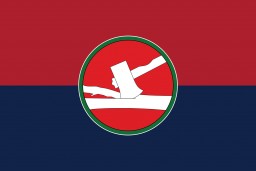
-
Flag graphic for US 86th Infantry Division
PhotoA digital representation of the United States 86th Infantry Division's flag. The US 86th Infantry Division (the "Blackhawk" division) was established in 1917 and fought in World War I. During World War II, they discovered the Attendorn civilian forced-labor camp. The 86th Infantry Division was recognized as a liberating unit in 1996 by the United States Army Center of Military History and the United States Holocaust Memorial Museum (USHMM).
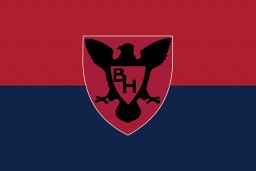
-
Flag graphic for US 89th Infantry Division
PhotoA digital representation of the United States 89th Infantry Division's flag. The US 89th Infantry Division (the "Rolling W" division) was established in 1917 and fought in World War I. During World War II, they captured the town of Eisenach and the city of Zwickau. The division overran Ohrdruf, a subcamp of Buchenwald. The 89th Infantry Division was recognized as a liberating unit in 1988 by the United States Army Center of Military History and the United States Holocaust Memorial Museum (USHMM).

-
Flag graphic for US 8th Armored Division
PhotoA digital representation of the United States 8th Armored Division's flag. The US 8th Armored Division is also known as the "Iron Snake" or "Thundering Herd" division. During World War II, they liberated Halberstadt-Zwieberge, a subcamp of Buchenwald. The 8th Armored Division was recognized as a liberating unit in 1995 by the United States Army Center of Military History and the United States Holocaust Memorial Museum (USHMM).
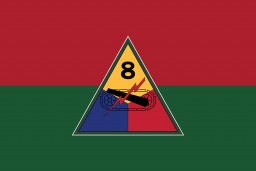
-
Flag graphic for US 8th Infantry Division
PhotoA digital representation of the United States 8th Infantry Division's flag. The US 8th Infantry Division (the "Golden Arrow" or "Pathfinder" division) was established in 1918 and fought in World War I. During World War II, they captured the cities of Rennes and Brest. The division also encountered Wöbbelin, a subcamp of Neuengamme. The 8th Infantry Division was recognized as a liberating unit in 1988 by the United States Army Center of Military History and the United States Holocaust Memorial Museum…
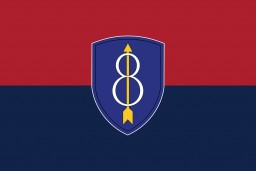
-
Flag graphic for US 90th Infantry Division
PhotoA digital representation of the United States 90th Infantry Division's flag. The US 90th Infantry Division (the "Tough Ombre" division) was established in 1917 and fought in World War I. During World War II, they were involved in D-Day and the Battle of the Bulge. The division also captured the city of Mainz and overran Flossenbürg concentration camp. The 90th Infantry Division was recognized as a liberating unit in 1985 by the United States Army Center of Military History and the United States…

-
Flag graphic for US 95th Infantry Division
PhotoA digital representation of the United States 95th Infantry Division's flag. The US 95th Infantry Division (the "Victory" Division) was established in 1942. During World War II, they captured the cities of Metz and Dortmund. The division also undercovered a German prison and civilian labor camp in Werl. The 95th Infantry Division was recognized as a liberating unit in 1995 by the United States Army Center of Military History and the United States Holocaust Memorial Museum (USHMM).

-
Flag graphic for US 99th Infantry Division
PhotoA digital representation of the United States 99th Infantry Division's flag. The US 99th Infantry Division (the "Checkerboard" or "Battle Babies" division) was established in 1942. During World War II, they were invovled in the Battle of the Bulge and liberated a Dachau subcamp near Mühldorf. The 99th Infantry Division was recognized as a liberating unit in 1992 by the United States Army Center of Military History and the United States Holocaust Memorial Museum (USHMM).
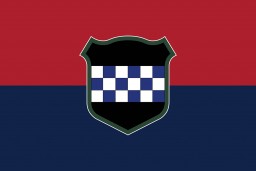
-
Flag graphic for US 9th Armored Division
PhotoA digital representation of the United States 9th Armored Division's flag. The US 9th Armored Division was known as the "Phantom" division. During World War II, they were involved in the Battle of the Bulge and also liberated Zwodau and Falkenau an der Eger, two subcamps of Flossenbürg. The 9th Armored Division was recognized as a liberating unit in 1993 by the United States Army Center of Military History and the United States Holocaust Memorial Museum (USHMM).

-
Former gas chamber in the Auschwitz main camp
PhotoPostwar photograph of gas chamber for mass murder in the Auschwitz main camp. Poland, ca. 1947. In mid-August 1940, Auschwitz concentration camp authorities put into operation a crematorium adjacent to a morgue. This building was located just outside the boundaries of the Auschwitz main camp. In September 1941, the morgue was converted to a gas chamber for mass murder where several hundred people could be killed at a time. This gas chamber was used until December 1942, though the crematorium remained…
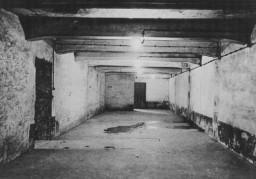
-
Thomas Buergenthal with one of his grandchildren
PhotoThomas with Eliza, one of his grandchildren. 1996. With the end of World War II and collapse of the Nazi regime, survivors of the Holocaust faced the daunting task of rebuilding their lives. With little in the way of financial resources and few, if any, surviving family members, most eventually emigrated from Europe to start their lives again. Between 1945 and 1952, more than 80,000 Holocaust survivors immigrated to the United States. Thomas was one of them.
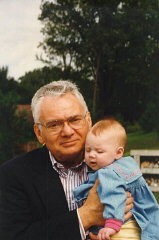
-
German General Headquarters, World War I
PhotoPictured from left to right: Field Marshal Paul von Hindenburg, Kaiser Wilhelm II, and General Erich Ludendorff study maps during World War I. January 1917.
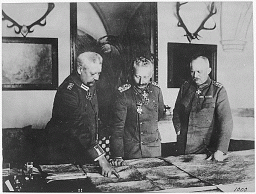
-
Paul von Hindenburg, 1917
PhotoField Marshal Paul von Hindenburg walks along a flower-covered path on his 70th birthday. On either side, crowds of children cheer. October 2, 1917. Hindenburg will later be elected president of Germany in 1925, during the Weimar Republic. © IWM Q 23976
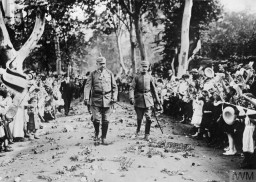
-
Demonstration in Berlin, November 1918
PhotoA public demonstration is held on the Unter den Linden in Berlin on November 9, 1918. On this day, Kaiser Wilhelm II abdicated the throne after a recent naval mutiny in Kiel inspired widespread revolution. © IWM Q 88164
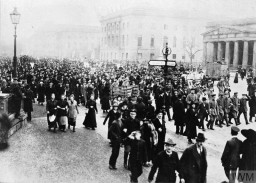
-
British soldiers transfer Jewish refugee children from the ship Theodor Herzl
PhotoIn April 1947, the British Navy intercepted the ship Theodor Herzl en route from Europe to British-controlled Mandatory Palestine. On board were hundreds of Holocaust survivors, including children, seeking a home. This photograph shows British soldiers transferring some of the Jewish refugee children to a vessel for deportation to Cyprus detention camps. Haifa port, British-controlled Mandatory Palestine, April 1947.

-
Nazi-era Antisemitic Propaganda Poster
PhotoNazi propaganda cartoon by Seppla (Josef Plank), a political cartoonist. Germany, date uncertain [probably during World War II]. Beginning in the 1920s, Nazi propagandists promoted the antisemitic myth that Jews were engaged in a massive conspiracy to take over the world. This false notion alleged that “international Jewry” used various people and groups as part of a plan for global conquest. At the time, an octopus extending its tentacles over the globe was a common visual metaphor for this…
